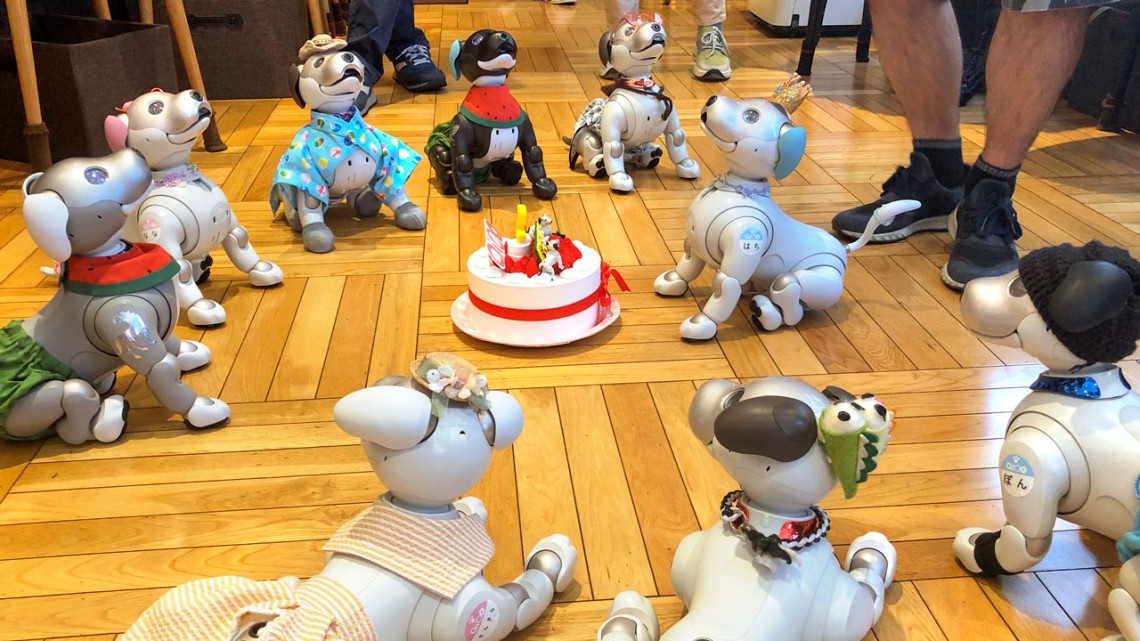
Sony aibo ERS-1000 robots and their human owners celebrate a birthday for one of the robots last summer at Tokyo’s Penguin Café, which hosts weekly meet-ups for aibo owners.
People, not design features, make a robot social
By Louis DiPietro
It takes a village to nurture social robots.
Researchers who develop social robots – ones that people interact with – focus too much on design features and not enough on sociological factors, like human-to-human interactions, the contexts where they happen and cultural norms involving robots, according to an award-winning paper from Cornell and Indiana University scholars who specialize in human-robot interaction.
“If we want to understand what makes a robot social, we have to look at the broader scope of the communities around robots and people’s interactions with each other,” said Malte Jung, co-author and associate professor of information science in the Cornell Ann S. Bowers College of Computing and Information Science and the Nancy H. ’62 and Philip M. ’62 Young Sesquicentennial Faculty Fellow. “Sociality is constructed through interactions people have with each other around the machine. It’s not just about programming a better character for the robot, making it respond better to human social features, making it look cuter or behaving more naturally.”
The team’s paper, “Constructing a Social Life with Robots: Shifting Away From Design Patterns Towards Interaction Ritual Chains,” won Best Paper at the Human-Robot Interaction conference, which was held March 11-14 in Boulder, Colorado. The research was based on field work by Waki Kamino, a doctoral student in the field of information science and the paper’s lead author, who spent months immersed in Tokyo’s robot-friendly culture.
In Tokyo, social robots offer owners the opportunity to interact with each other and have fun, Kamino said. Three social robots in particular – Sony’s aibo, SHARP’s RoBoHoN, and Groove X’s LOVOT – each have expansive communities of like-minded owners who regularly meet up and host social events involving the robots. Owners have “added robots into their social rituals,” Kamino said. They meet up for coffee or throw birthday parties for their robots.
“These people are sometimes portrayed as isolated, eccentric or lonely but in fact have rich friend connections,” she said, “and sometimes these connections are facilitated by robots.”
Kamino visited homes, robot stores, cafés and conventions, and interviewed people about their robot-accompanied lifestyles. Her work informed one of the paper’s primary findings: In Japan, manufacturers and robot owners together helped establish new norms for robots as social agents. Companies incorporated familiar designs into their robots and brought owners together by hosting sponsored events, while owners made their robots part of everyday interactions with friends and met up regularly in public spaces, robots in tow.
Robots also provide emotional support, Kamino found.
In interviews, she heard from a couple that chose a robot over a living pet because there was less “emotional risk” and even planned for their robot’s future care when the couple died. Kamino learned another family’s robot was often their late mother’s only companion while she was hospitalized during the pandemic.
The research team calls on the field of human-robot interaction (HRI) to consider a broader sociological view when designing and building robot companions.
“Traditionally, HRI research has always looked at just this one interaction between one person and one robot,” Jung said. “We really have to look at the broader scope of the communities around people's interactions with each other and take all of this into consideration.”
“Waki’s research shows that using robots doesn’t mean you’re isolating yourself with the robot,” said Selma Šabanović, professor in the Luddy School of Informatics, Computing, and Engineering at Indiana University and a paper co-author. “Interacting with robots is actually a social practice that you do together with others.”
Louis DiPietro is a writer for the Cornell Ann S. Bowers College of Computing and Information Science.
Media Contact
Get Cornell news delivered right to your inbox.
Subscribe
